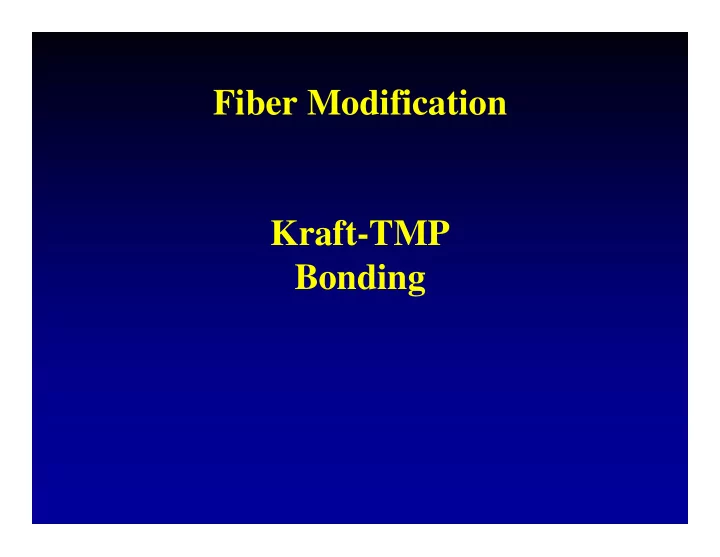

Fiber Modification Kraft-TMP Bonding
Fiber Modification: Fiber Bond Enhancement Background: What is unknown • Why tensile strength of TMP-made paper is weaker than KP-made paper? Weaker bonding or something else? • Structure of interfiber bonding has focused on chemical pulp sheets. However, there are no comprehensive models for describing the structure of mechanical pulp bonds. • Mechanism of bond enhancement by bonding agents was studied for chemical pulp. Same study should be prosecuted to understand the mechanical pulp bonding for the development of bond enhancement strategy.
Fiber Modification: Fiber Bond Enhancement Background: What needs to be understood • Structure of mechanical pulp bond – Surface of long fibers and fines (layer separation by pulping) – Contact between fines and long fibers – Chemical contamination on the surface (extractives) – TMP/TMP bond – TMP/KP bond – KP/KP bond • Effect of bonding agent on the mode of bond breakage
Fiber Modification: Fiber Bond Enhancement • How to approach to the mechanical pulp sheet bonding
Fiber Modification: Fiber Bond Enhancement
Fiber Modification: Fiber Bond Enhancement
Fiber Modification: Fiber Bond Enhancement
Fiber Modification: Fiber Bond Enhancement
Fiber Modification: Fiber Bond Enhancement
Fiber Modification: Fiber Bond Enhancement
Fiber Modification: Fiber Bond Enhancement
Fiber Modification: Fiber Bond Enhancement
Fiber Modification: Fiber Bond Enhancement
Fiber Modification: Fiber Bond Enhancement
Fiber Modification: Fiber Bond Enhancement
Effect of bonding agent dosage on the mode of bond breakage • Significance – It is believed that improvement of tensile strength of paper by addition of bonding agents is due to the increase of specific bond strength (bond strength/bonded area) not by the increase of the bonded area. – Observation of broken bond will provide insight into how bonding agents improve bond strength.
Visualization of broken bonds by vapor phase osmium coating of paper Sheet splitting Coating of internal surface of paper by osmium
Handsheet used for sheet splitting Cationic Potato Starch Pulp: Southern Pine Bleached Kraft 75 Tensile, N m/g Freeness: 500 ml CSF 70 65 Starch: cationic potato starch 60 55 Dosage: 0.3, 0.5, 1.0, 2.0% 50 0 0.5 1 1.5 2 Dosage, %
Bond breakage mode: type A Very smooth surface with no fibrils rising from it
Bond breakage mode: type B Relatively smooth surface with some fibrils rising from it
Bond breakage mode: type C The S1 layer is broken and partially peeled off from the S2
Bond breakage mode: type D The S1 is peeled off and the S2 is exposed
Effect of C-starch dosage on the bond breakage mode 80 80 70 Dosage: 0% Dosage: 1.0% 58 60 60 40 32 40 19 20 11 20 6 4 0 0 0 A B C D A B C D 80 80 Dosage: 0.3% Dosage: 2.0% 60 54 60 60 38 37 40 40 20 20 4 4 3 0 0 0 A B C D A B C D 80 Dosage: 0.5% 60 44 33 40 23 20 0 0 A B C D
Mechanism of Fiber-Fiber Bonding Conclusions • The improvement of paper tensile strength is not simply due to the increase of specific bond strength. • The position of the bond breakage shifts from the bonded surface to the S1, and to the S1/S2 border with the increase of dosage of the bonding agent.
Recommend
More recommend